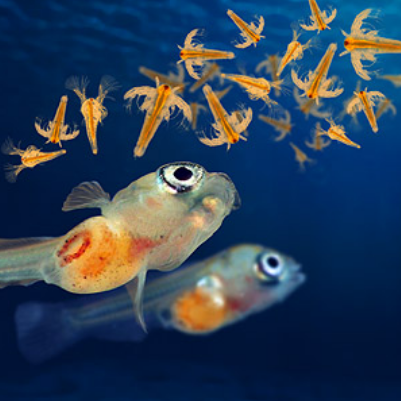Reproductive characteristics of Artemia
In the Artemia life cycle, it consumes 3 weeks to nourish them from eggs to the matures. Artemia is classified into an aquatic branchiopoda class which is a one class of crustaceans subphylum. Artemia is also known as brine shrimp.

• Ovoviviparous reproduction is that eggs are fertilized to grow up into nauplius in the uterus. Then, the mothers will release nauplius into water.
• Oviparous reproduction means that fertilized eggs will only develop up to the gastrula stage. At this moment they get surrounded by a thick shell, enter a state of metabolic standstill or dormancy (diapause) and are then released by the female.
Many researches show that dissolved oxygen content, salinity, vibratile amplitude of oxygen content and iron content in food are the key factors affecting the reproduction method of Artemia. In detail, if the environment has high content oxygen, low salinity, short amplitude of oxygen content and food with low concentration of iron, Artemia will tend to produce the younger generation via ovoviviparous reproduction. By contrast, Artemia will carry on the oviparous reproduction (reproducing cysts). However, some other studies illustrate that temperature is another factor affect the reproduction method of Artemia. Each female can make 1.500-2.500 cysts or nauplius
Source: vietlinh.vn
Translator: KIS Administration
Source: vietlinh.vn
About Us
Quality Policy
KIS has apllied the Quality Management System and got ISO 9001:2015 certificate in order to ensure consulting quality that covered by quality policy as the following: “KIS Leadership commit to support the staffs promote their technical experiences and professional ethics in order to meet the...
| Ho Chi Minh Branch | Can Tho Branch | Da Nang Branch | Hai Phong Branch |
| Add : 163 Dien Bien Phu, 15 Ward, Binh Thanh Dist., Ho Chi Minh City Hotline : 0942996688 | Add : 2-63, 6 Road, 586 Zone, Phu Thu, Cai Rang Dist., Can Tho City Hotline : 0942996688 | Add : 3rd floor, lot 103, 30/4 Road, Hai Chau Dist., Da Nang City Hotline : 0942996688 | Add : 422 Da Nang Str, Dong Hai 1 Ward, Hai An Dist., Hai Phong City Hotline : 0942996688 |

